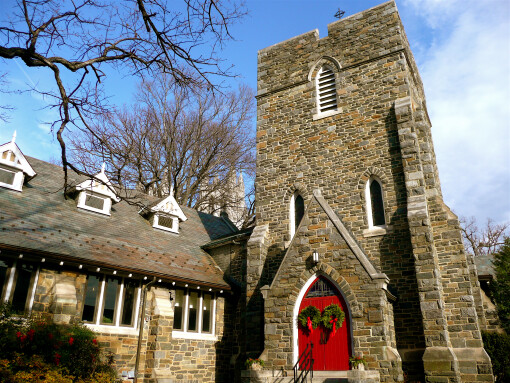Boundary Violations & Border Crossings: Talitha Cum!

Series: Pentecost
Speaker: The Rev'd Jim Quigley
In hearing the pair of healing stories in today’s passage from Mark’s gospel we might be tempted toward asking a profoundly existential question: Can Jesus heal me? The need for healing is ubiquitous. Personal, physical, spiritual, emotional, communal or societal, our need for healing, or salvation, abounds. Can Jesus heal us? These healing stories also raise a pastoral dilemma for people seeking God or faith whether in first century Palestine or any time in human history: Why are some healed and others not? Jesus healed Jarius’ daughter so why not mine? Why the woman with the flow of blood and not my husband? Is God really a healer, or not? Jesus told the woman with the flow of blood that it was her faith, not him, that made her well. So, if that’s really the case, does my own suffering or the suffering of others come as a result of a faith that is lacking? Yes? No? Maybe so?
While keeping in mind the cognitive dissonance that miracle stories like these and others throughout the bible evoke within us and while being pastorally sensitive to how a preacher might as easily provoke dread as much as hope in the hearts of the faithful by attempting to answer these types of questions, a more nuanced understanding of the scripture before us might be in store for us today. A slower, or maybe a quieter reading of the text, and our listening for what the story might be trying to tell us or teach us about how God’s Kingdom was made manifest in Jesus’ day, and as a corollary how God’s Kingdom might be made manifest in our own, might be revealing. That slower reading, to be sure, won’t answer any of our existential questions but might well lead us to a more faithful or bolder or riskier witness in God’s world.
So here goes. We need to do a little unpacking. At this point in Mark’s Gospel Jesus is on the move. Today’s scripture passage begins as a great crowd gathers around him after he “had crossed again to the other side.” He’s been casting out demons and curing the sick and that’s what has garnered all of the attention, but he’s also been crossing boundaries. Going back and forth between Jewish and Gentile, or non-Jewish, regions. This morning he’s back in his own territory when Jarius, a leader in the synagogue, fall to Jesus’ feet while repeatedly begging him to come and lay hands on his daughter so that she may “be made well – sozo - and live.” So, Jesus goes. Along the way the woman with the hemorrhage comes. Given where they are she’s likely Jewish. She’s been bleeding for twelve years without a cure. Her condition and her orthodoxy declare her unclean, impure, alienated from family and friends, untouchable and unable to touch. Which means she’s also desperate, unnoticed. Desperate and unnoticed people do desperate things and so she violates, or reaches past the purity codes, seeking her salvation. She makes her way through the crowds, grabs the tzitzit dangling from Jesus’ robe and immediately she feels as if she’s been released from her bondage.
I don’t want to get too far into the weeds here but the next thing that happens in Mark’s story seems a little strange. After being touched, Jesus, immediately aware that “Power had gone forth from him,” asks, “who touched me?” His disciples’ response to him is ironic: “Who touched you, you ask? You see these crowds; don’t you mean who didn’t touch you?” But the boundary was violated. And Jesus knew it. The unclean had touched the clean. An offense, a violation, had occurred. Jesus was now ritually impure. Which means that now he can’t touch anybody either. Not without a few ritual baths and a few days outside the tent. Purell can’t fix this. And we remember what he was on his way to do. To touch Jarius’ daughter so that she too, could be saved. The woman, this time, not Jarius, falls at Jesus’ feet, in fear and trembling, and confesses to Jesus “her whole truth.” The boundary violator confesses to the boundary keeper, and the boundary keeper responds with compassion, not separation. “Daughter, your faith has made you well; go in peace and be healed of your dis-ease… your citizenship as a beloved child of God and your membership in the beloved community is restored, welcome to the Kingdom of God!”
And of course, the story goes on from there, gets thicker. By the time Jesus gets to Jarius’ house the girl is dead. She was only… twelve. The woman suffered for twelve years and the girl was only twelve years old. Hopefully we’ve all been engaged in scripture long enough to know why Mark uses that number. Twelve sons of Jacob. Creating the twelve tribes. Jesus calling the twelve apostles. Twelve, twelve, twelve. I’m not a numerology guy but some do say that twelve is the result of three – representing the divine – and four – representing the cosmos – meet. When temporal governance reflects God’s justice and loving-kindness. Thy Kingdom come, thy will be done, on earth as it is in heaven… Talitha cum.
As Ched Meyers, my favorite interpreter of Mark’s Gospel summarizes this healing story – or salvation/sozo narrative – Mark’s story shows that only when the outcast is restored to true daughterhood can the daughter of the synagogue be restored to true life. This is the faith that the privileged must learn from the poor. That the citizen must learn from the alien. And it’s a story that summarily might be rendered as the reality that only when the last are first will God’s Kingdom come. Only when the outcast is restored to true daughterhood can the daughter of the synagogue be restored to true life.
In Mark’s story, Jarius, the leader of the synagogue is, metaphorically at least, the leader of a nation. His daughter is dying and this daughter is, undoubtedly for Mark, a symbol. Not only is the synagogue dying but so are its children. Jarius was the overseer of a body politic that so badly needed repentance and “res-torah-tion”. By the end of the pericope not only the woman with the hemorrhage but Jarius – and we might add Jesus too – all violated their own orthodoxy in the name of compassion or necessity. The Kingdom came.
When writing this sermon and reading Mark’s story, I couldn’t help but to remember Rosa Parks and the day when after years of suffering as an African American woman she just got tired and decided to touch Jesus’ cloak and take her seat on the front of that Montgomery bus, inspiring a nation to repentance, to healing, to salvation. So many years later – fifty or more – our body politic is guilty of not heeding her witness. Still later when reading a recent issue of The Christian Century I read a commentary on the passage from Mark’s Gospel appointed for this week by Willie Dwayne Francois III, senior pastor of Mount Zion Baptist Church in Pleasantville, NJ: “Resilient, rebellious reaches threaten the logic of exclusion and the politics of purity. Harriet Tubman built an underground railroad. Nannie Helen Burroughs reshaped education for black women and girls. Jarena Lee preached the gospel in a sexist church. Ida B. Wells exposed the atrocities of American Lynching. Fannie Lou Hammer, who was “sick and tired of being sick and tired,” changed the Democratic party…. We have to keep reaching for moral high ground and for justice. Your next reach may shift the history of the world.”
In the name of God, and in our customary time of silence in response to the Gospel, we remember all who pray, or beg, for healing and restoration or repentance. We pray for the leaders of this land. We remember friends and loved ones and all who suffer, especially those whose lives demand the desperate crossing of the many human boundaries that prevent life and salvation for all. Help us Lord, to preserve the boundaries that keep us whole and to break down those which only divide. We repent of the evil we have done and the evil on our behalf. In your mercy, Lord, heal us, whatever your healing and salvation means for each of us. Inspire our next reach and help us shift the history of the world.
Amen
 Welcome to St. Alban’s Church! Every Sunday, and most days in between, people gather in this place to worship, to learn, to grow, to share the joys and struggles of our lives, and to seek God’s grace in the midst of our lives. We do not come because we have it all figured out, but because we are seeking light on the way. We come as we are and welcome one another.
Welcome to St. Alban’s Church! Every Sunday, and most days in between, people gather in this place to worship, to learn, to grow, to share the joys and struggles of our lives, and to seek God’s grace in the midst of our lives. We do not come because we have it all figured out, but because we are seeking light on the way. We come as we are and welcome one another.

